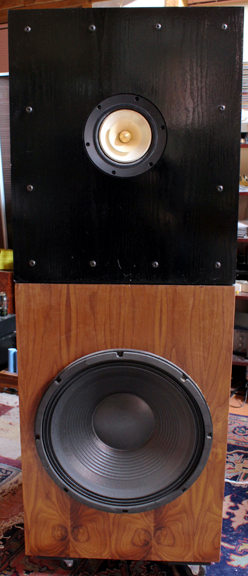|
Tip #81
The Basszilla Feastrex Edition
by Dick Olsher (August 2012)
 The Feastrex Edition, the latest Basszilla option, perfectly illustrates the unifying theme of the Basszilla loudspeaker family. It has always been about a specific modular approach to speaker design, deploying the Basszilla woofer enclosure as a foundation for an open-baffle mounted wide or full-range driver. In this case, the bass foundation is identical to that of the Platinum Edition, as is the Kevin Kerwin open baffle. What is different has to do with the application of the Feastrex 5-Dnf full-range driver, which is allowed to work as a wide range above a frequency of about 200 Hz. The Feastrex Edition, the latest Basszilla option, perfectly illustrates the unifying theme of the Basszilla loudspeaker family. It has always been about a specific modular approach to speaker design, deploying the Basszilla woofer enclosure as a foundation for an open-baffle mounted wide or full-range driver. In this case, the bass foundation is identical to that of the Platinum Edition, as is the Kevin Kerwin open baffle. What is different has to do with the application of the Feastrex 5-Dnf full-range driver, which is allowed to work as a wide range above a frequency of about 200 Hz.
The idea has been percolating in the back of my head since the OB2 design was published in 2007 (http://www.blackdahlia.com/html/tip_59.html), but only recently did I find the time and energy to delve deeply into this project. It became clear that the original D-5nf’s high-pass network deployed in the OB2 does not offer adequate protection against over excursion in the mid bass. The reason for this should be obvious from Figure 1, where the orange trace gives the D-5nf’s impedance magnitude in the Basszilla open baffle. The mechanical resonance peak is located at a frequency of 125 Hz, and prevents the crossover network from rolling off smoothly. Granted that the exact peak location may shift slightly due to drive signal magnitude and variations in suspension compliance from sample to sample, but the resonance is just too close to the crossover frequency for comfort. By the way, I did calculate several T-S parameters based on this sample of one, and for the record they are: Qms=7.445, Qes=0.707, and Qt=0.646.
I decided to bite the bullet and invest in an LCR notch filter in order to remove the impedance peak. The impact of the notch filter is shown in Figure 1 as the blue trace. This was not an easy decision to make due to the added component cost, but as with all of the crossover decisions, the design was finalized on the basis of critical listening tests. And to be clear, several high and low-pass networks were evaluated with and without the notch filter. In all cases, the notch filter reduced upper bass congestion and allowed the D-5nf to breathe in a more relaxed fashion and with greater headroom. The final crossover design and the clear sonic winner is shown in Figure 2. It’s an asymmetric type consisting of a second order low-pass for the woofer and a third-order high-pass for the D-5nf. Note that the 158 uF cap is built up in parallel using two 51 uF, one 41 uF AXON metalized Polypropylene caps, and one 15 uF Auricap. The 143 uF cap is built up in parallel using two 51 uF and one 41 uF AXON metalized polypropylene caps. All caps are bypassed with a 0.01 uF Teflon cap. The resistor in the LCR filter should be rated at least at 10W.
The impedance magnitude of the Basszilla Feastrex Edition is shown in Figure 3, while the in-room measured response at about 1 meter on the D-5nf axis (actually at a distance of about 44 inches) is shown in Figure 4. The orange trace was measured with the First Watt SIT-1 monoblocks while the blue trace represents the response with the JE Audio VM60 tube monoblocks. Ironically, the solid-state SIT-1 with its 4-Ohm source impedance interacts more actively with the speaker load than does the tube amp whose source impedance is only 0.7 Ohm. The SIT-1 alters the tonal balance slightly by shaving off some mid and upper bass response, but otherwise partnered the Feastrex Basszilla most admirably.
It is remarkable that a twin-cone full-range, ostensibly 1930s technology, is still viable today. The D-5nf is the only full-range I’ve auditioned to date that I can actually enjoy full range without seriously considering tweeter augmentation. OK, so the whizzer cone’s treble range reproduction isn’t quite right harmonically, and neither is it as refined as that of a high-end ribbon tweeter, but it is surprisingly detailed and well controlled. The real reason to fall in love with the D-5nf is all about the midrange, specifically, lucid, sweet textures that sing with emotional bravado. Coupled with an exceedingly coherent and transparent soundstage, the Feastrex Edition is capable of portraying a panoramic spatial perspective. The voicing of the Feastrex Edition is such that the lower midrange, the power range of the orchestra, comes through with superb clarity and dynamics. It is a wonderful vehicle for enjoying the music till the end of time.
|